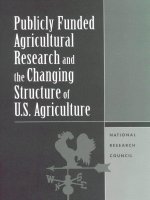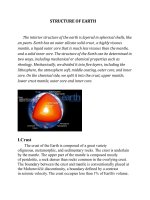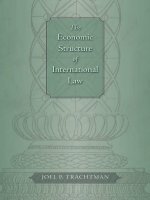STRUCTURE OF POLYSACCHARIDES
Bạn đang xem bản rút gọn của tài liệu. Xem và tải ngay bản đầy đủ của tài liệu tại đây (388.89 KB, 10 trang )
2 Structure of Polysaccharides
2.1 Structural Features
There is a wide range of naturally occurring polysaccharides derived from plants,
microorganisms, fungi, marine organisms and animals possessing magnificent
structural diversity and functional versatility. In Table 2.1, polysaccharides most
commonly used for polymeranalogous reactions are summarised according to
chemical structures. These include glucans (1–8), fructans (11), aminodeoxy glu-
cans (12, 13), and polysaccharides with uronic acid units (14).
Table 2.1. Structures of polysaccharides of different origin
Polysaccharide Reference
Type Source Structure
Cellulose 1 Plants
β
-(1→4)-d-glucose [6]
Curdlan 2 Bacteria
β
-(1→3)-d-glucose [7]
Scleroglucan 3 Fungi
β
-(1→3)-d-glucose main chain, [8]
β
-(1→6)-d-glucose branches
Schizophyllan 4 Fungi
β
-(1→3)-d-glucose main chain, [9, 10]
d-glucose branches
Dextran 5 Bacteria
α
-(1→6)-d-glucose main chain [11]
Pullulan 6 Fungi
α
-(1→6) linked maltotriosyl units [12]
Starch Plants [13]
Amylose 7
α
-(1→4)-d-glucose
Amylopectin 8
α
-(1→4)- and
α
-(1→6)-d-glucose
Xylan 9 Plants
β
-(1→4)-d-xylose main chain [14]
Guar 10 Plants
β
-(1→4)-d-mannose main chain, [15]
d-galactose branches
Inulin 11 Plants
β
-(1→2)-fructofuranose [16]
Chitin 12 Animals
β
-(1→4)-d-(N-acetyl)glucosamine [17]
Chitosan 13
β
-(1→4)-d-glucosamine
Alginate 14 Algae
α
-(1→4)-l-guluronic acid [18]
β
-(1→4)-d-mannuronic acid
6 2 Structure of Polysaccharides
The common motifs are primary and secondary OH groups and carboxylic acid
moieties, accessible to esterification, and NH
2
groups for conversion to amides.
In addition, comprehensive reviews about the molecular, supramolecular and
morphological structures of the polysaccharides are available [9, 19–23].
2.1.1 Cellulose
Cellulose, the most abundant organic compound, is a linear homopolymer com-
posed of d-glucopyranose units (so-called anhydroglucose units) that are linked
together by
β
-(1→4) glycosidic bonds (Fig. 2.1). Although cellulose possesses
a unique and simple molecular structure, very complex supramolecular structures
can be formed, which show a rather remarkable influence on properties such as
reactivity during chemical modification. The complexity of the different structural
levels of cellulose, i.e. the molecular, supramolecular and morphological, is well
studied [24]. The polymer is insoluble in water, even at a rather low DP of 30, and in
common organic solvents, resulting from the very strong hydrogen bond network
formed by the hydroxyl groups and the ring and bridge oxygen atoms both within
and between the polymer chains. The ordered hydrogen bond systems form var-
ious types of supramolecular semicrystalline structures. This hydrogen bonding
has a strong influence on the whole chemical behaviour of cellulose [25, 26].
To dissolve the polymer, various complex solvent mixtures have been evaluated
and are most often employed in esterification reactions such as DMAc/LiCl and
DMSO/TBAF. A well-resolved
13
C NMR spectrum of the polymer dissolved in
DMSO-d
6
/TBAF, including the assignment of the 6 carbon atoms, is shown in
Fig. 2.1 [27].
The carbon atoms of position 2, 3 and 6 possess hydroxyl groups that undergo
standard reactions known for primary and secondary OH moieties. Cellulose of
various DP values is available, depending on the source and pre-treatment. Native
cotton possesses values up to 12 000 while the DP of scoured and bleached cotton
linters rangesfrom 800 to 1800 andof wood pulp(dissolving pulp)from 600 to 1200.
Fig. 2.1.
13
C NMR spectrum of cellulose dissolved in DMSO-d
6
/TBAF (reproduced with permission
from [27], copyright Wiley VCH)
2.1 Structural Features 7
Table 2.2. Carbohydrate composition, DP, and crystallinity of commercially available celluloses
Sample Producer Carbohydrate composition (%) DP Crystallinity
Glucose Mannose Xylose (%)
Avicel Fluka 100.0 – – 280 61
Sulphate pulp V-60 Buckeye 95.3 1.6 3.1 800 54
Sulphate pulp A-6 Buckeye 96.0 1.8 2.2 2000 52
Sulphite pulp 5-V-5 Borregaard 95.5 2.0 2.5 800 54
Linters Buckeye 100.0 – – 1470 63
Table 2.2 gives some examples of cellulose with a high variety of DP valuesuseful for
chemical modification. Another approach to pure cellulose is the laboratory-scale
synthesisofthepolymerbyAcetobacter xylinum and Acanthamoeba castellani [28],
which circumvents problems associated with the extraction of cellulose.
2.1.2
β
-(1→3)-Glucans
There are a number of structural variations within the class of polysaccharides
classified as
β
-(1→3)-glucans. The group of
β
-(1→3, 1→6) linked glucans has
been shown to stimulate and enhance the human immune system.
Althoughpolysaccharidesofthecurdlantypearepresentinavarietyofliv-
ing organisms including fungi, yeasts, algae, bacteria and higher plants, until now
only bacteria belonging to the Alcaligenes and Agrobacterium genera have been re-
ported to produce the linear homopolymer. Curdlan formed by bacteria including
Agrobacterium biovar and Alcaligenes faecalis is a homopolymer of
β
-(1→3)-d-
glucose, determined by both chemical and enzymatic analysis (Fig. 2.2, [29]). Thus,
this
β
-glucan is unbranched. The DP is approximately 450 and the polymer is sol-
uble in both DMSO and dilute aqueous NaOH. About 700 t of the polysaccharide
are commercially produced in Japan annually.
Scleroglucan is a neutral homopolysaccharide consisting of linear
β
-(1→3)
linked d-glucose, which contains a
β
-(1→6) linked d-glucose at every third re-
peating unit of the main chain on average (Fig. 2.2, [8]). The polysaccharide is
solubleinwaterandDMSO.ScleroglucanisformedextracellularlybySclerotium
glucanicum and other species of Sclerotium. The polysaccharide schizophyllan
Fig. 2.2. Chemical structure of
β
-(1→3)-glucans: curdlan (R
=
H), scleroglucan (R
= β
-d-
glucopyranosyl moiety)
8 2 Structure of Polysaccharides
synthesised by Schizophyllum commune possesses the same primary structure as
scleroglucan [30].
Scleroglucan, schizophyllan and curdlan have found some attention within the
context of chemical modification.
2.1.3 Dextran
Dextran, produced by numerous strains of bacteria (Leuconostoc and Strepto-
coccus), is a family of neutral polysaccharides consisting of a
α
-(1→6) linked
d-glucose main chain with varying proportions of linkages and branches, de-
pending on the bacteria used. The
α
-(1→6) linkages in dextran may vary from
97 to 50% of total glycosidic bonds. The balance represents
α
-(1→2),
α
-(1→3),
and
α
-(1→6) linkages usually bound as branches [31]. The commercially applied
single strain of Leuconostoc mesenteroides NRRL B-512F produces a dextran ex-
tracellularly (Fig. 2.3) that is linked predominately by
α
-(1→6) glycosidic bonds
with a relatively low level (∼5%) of randomly distributed
α
-(1→3) branched link-
ages [32]. The majority of side chains (branches) contain one to two glucose units.
The dextran of this structure is generally soluble in water and other solvents (for-
mamide, glycerol). The commercial production carried out by various companies
is estimated to be ca. 2000 t
/
year worldwide [33].
Fig. 2.3. Structure of dextran obtained from Leuconostoc
mesenteroides NRRL B-512F. R
=
predominately H and 5% glu-
cose or
α
-(1→6) linked glucopyranosyl-
α
-d-glucopyranoside
2.1.4 Pullulan
Pullulan is a water-soluble, neutral polysaccharide formed extracellularly by cer-
tain strains of the polymorphic fungus Aureobasidium pullulans.Itisnowwidely
accepted that pullulan is a linear polymer with maltotriosyl repeating units joined
by
α
-(1→6) linkages [12, 34]. The maltotriosyl units consist of
α
-(1→4) linked
d-glucose (Fig. 2.4). Consequently, the molecular structure of pullulan is interme-
diate between amylose and dextran because it contains both types of glycosidic
bonds in one polymer.
2.1 Structural Features 9
Fig. 2.4. Structure of pullulan
The polysaccharide possesses hydroxyl groups at position 2, 3 and 4 of different
reactivity (Fig. 2.4). The structure of pullulan has been analysed by
13
Cand
1
H
NMR spectroscopic studies using D
2
OorDMSO-d
6
as solvents [35]. The repeating
unit linked by
α
-(1→6) bond shows a greater motional freedom than the units
connected by
α
(1→4), which may influence the functionalisation pattern obtained
by chemical modification in particular homogeneously in dilute solution.
2.1.5 Starch
Starch consists of two primary polymers containing d-glucose, namely the linear
α
-(1→4) linked amylose and the amylopectin that is composed of
α
-(1→4) linked
d-glucose and
α
-(1→6) linked branches (Fig. 2.5). The molecular mass of amylose
is in the range 10
5
–10
6
, while amylopectin shows significantly higher values of
10
7
–10
8
[13]. Amylose and amylopectin occur in varying ratios depending on the
plant species (Table 2.3).
Table 2.3. Typical starch materials, their composition, and suppliers
Starch type Amylose Supplier Contact
content (%)
Hylon VII 70 National starch www.nationalstarch.com
Amioca powder 1 National starch www.nationalstarch.com
Potato starch 28 Emsland Stärke www.emsland-staerke.de
Waxy maize starch 1 Cerestar www.cerestar.com
2.1.6 Hemicelluloses
Hemicelluloses are among the most abundant polysaccharides in the world, since
they constitute 20–30% of the total bulk of annual and perennial plants. According
to the classical definition, hemicelluloses are cell wall polysaccharides that are









